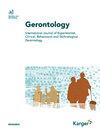Decreased phagocytosis and intracellular killing of bacteria in leukocytes of geriatric patients with Clostridioides difficile infections.
IF 3
3区 医学
Q3 GERIATRICS & GERONTOLOGY
引用次数: 0
Abstract
INTRODUCTION Patients suffering from a Clostridioides (C.) difficile infection have a higher overall mortality than patients with similar co-morbidities. METHODS Whole blood samples of 15 patients with C. difficile enteritis and 15 control patients matched for age and sex were used to analyse the capacity of blood phagocytes to internalize and kill encapsulated Escherichia (E.) coli. The median age of C. difficile patients and control patients was 81 and 82 years, respectively. Blood samples were co-incubated with E. coli for 15 or 30min. After 15min of co-incubation, extracellular bacteria were killed by gentamicin for 15-45 minutes. Then eukaryotic cells were lysed with distilled water, and the number of intracellular bacteria per ml whole blood was determined by quantitative plating on agar plates. Both groups were compared by Mann-Whitney U-test. RESULTS After 15 or 30min of co-incubation, blood phagocytes from patients with C. difficile enteritis showed a reduced density of phagocytosed or adherent bacteria in comparison to blood phagocytes from control patients (15min: p=0.046, 30min: p=0.005). The density of intracellular bacteria decreased less rapidly over time in the blood from C. difficile patients [median Δlog CFU/ml x h (25th/ 75th percentile) -0.893 (-1.893/ -0.554) versus -1.483 (-2.509/ -1.028); p=0.02]. In line with these results, the percentage of intracellularly killed bacteria was decreased in phagocytes from C. difficile-infected patients compared to controls (median intracellular killing rate 64.3% for blood phagocytes from C. difficile patients versus 81.9% for blood phagocytes from control patients within 30 min of co-incubation, p = 0.048). CONCLUSION Blood phagocytes from patients with C. difficile enteritis exhibited a reduced capacity to phagocytose and kill bacteria in comparison to blood phagocytes from age- and sex-matched control patients. Patients with C. difficile infection may have a higher disposition to develop infectious diseases than age- and sex-matched control patients.难辨梭状芽孢杆菌感染的老年患者白细胞吞噬能力和细胞内杀灭细菌能力下降。
方法采用 15 名艰难梭菌肠炎患者和 15 名年龄和性别匹配的对照组患者的全血样本,分析血液吞噬细胞内化和杀死包裹的大肠杆菌的能力。艰难梭菌患者和对照组患者的中位年龄分别为 81 岁和 82 岁。血液样本与大肠杆菌共孵育 15 或 30 分钟。共培养 15 分钟后,用庆大霉素杀死细胞外细菌 15-45 分钟。然后用蒸馏水裂解真核细胞,将其定量培养在琼脂平板上,测定每毫升全血中的细胞内细菌数。结果15或30分钟共孵育后,艰难梭菌肠炎患者的血液吞噬细胞与对照组患者的血液吞噬细胞相比,吞噬或粘附细菌的密度降低(15分钟:P=0.046;30分钟:P=0.005)。艰难梭菌患者血液中的细胞内细菌密度随时间下降的速度较慢[中位数Δlog CFU/ml x h(第25/75百分位数)-0.893(-1.893/ -0.554)对-1.483(-2.509/ -1.028);p=0.02]。与这些结果一致的是,与对照组相比,艰难梭菌感染患者的吞噬细胞细胞内杀灭细菌的百分比有所下降(艰难梭菌患者血液吞噬细胞细胞内杀灭率中位数为 64.3%,而对照组为 81.9%)。艰难梭菌肠炎患者的血液吞噬细胞与年龄和性别匹配的对照组患者的血液吞噬细胞相比,吞噬和杀灭细菌的能力下降。与年龄和性别匹配的对照组患者相比,艰难梭菌感染患者可能更容易患上感染性疾病。
本文章由计算机程序翻译,如有差异,请以英文原文为准。
求助全文
约1分钟内获得全文
求助全文
来源期刊

Gerontology
医学-老年医学
CiteScore
6.00
自引率
0.00%
发文量
94
审稿时长
6-12 weeks
期刊介绍:
In view of the ever-increasing fraction of elderly people, understanding the mechanisms of aging and age-related diseases has become a matter of urgent necessity. ''Gerontology'', the oldest journal in the field, responds to this need by drawing topical contributions from multiple disciplines to support the fundamental goals of extending active life and enhancing its quality. The range of papers is classified into four sections. In the Clinical Section, the aetiology, pathogenesis, prevention and treatment of agerelated diseases are discussed from a gerontological rather than a geriatric viewpoint. The Experimental Section contains up-to-date contributions from basic gerontological research. Papers dealing with behavioural development and related topics are placed in the Behavioural Science Section. Basic aspects of regeneration in different experimental biological systems as well as in the context of medical applications are dealt with in a special section that also contains information on technological advances for the elderly. Providing a primary source of high-quality papers covering all aspects of aging in humans and animals, ''Gerontology'' serves as an ideal information tool for all readers interested in the topic of aging from a broad perspective.
 求助内容:
求助内容: 应助结果提醒方式:
应助结果提醒方式:


